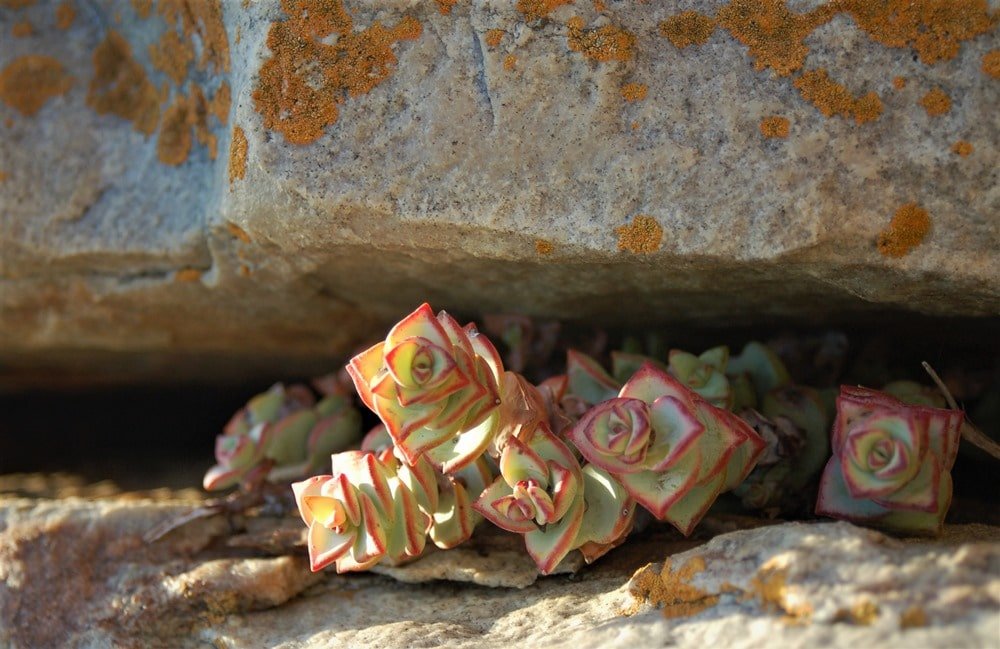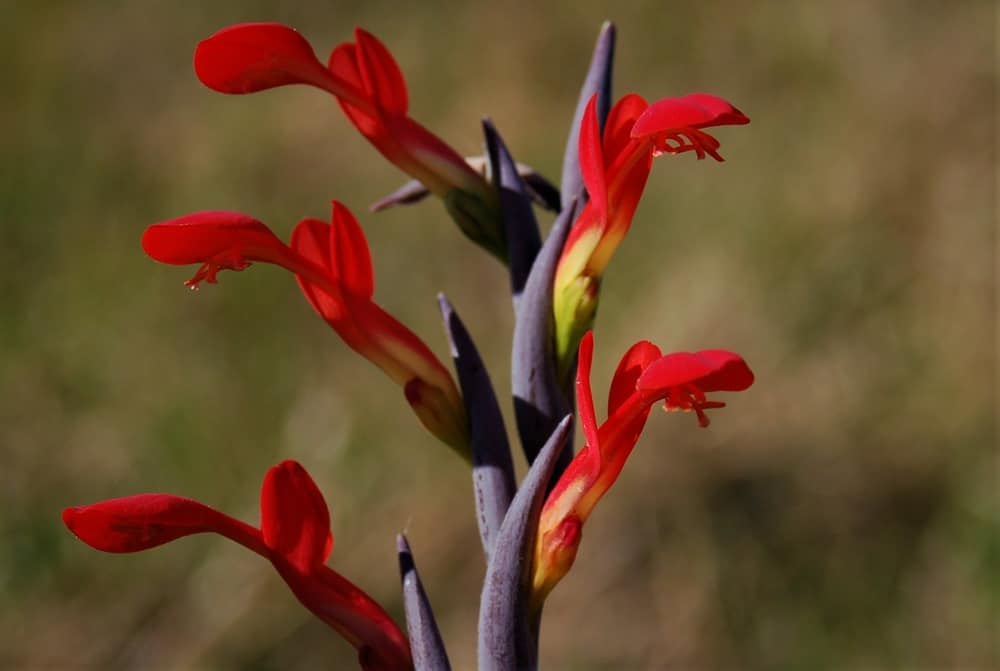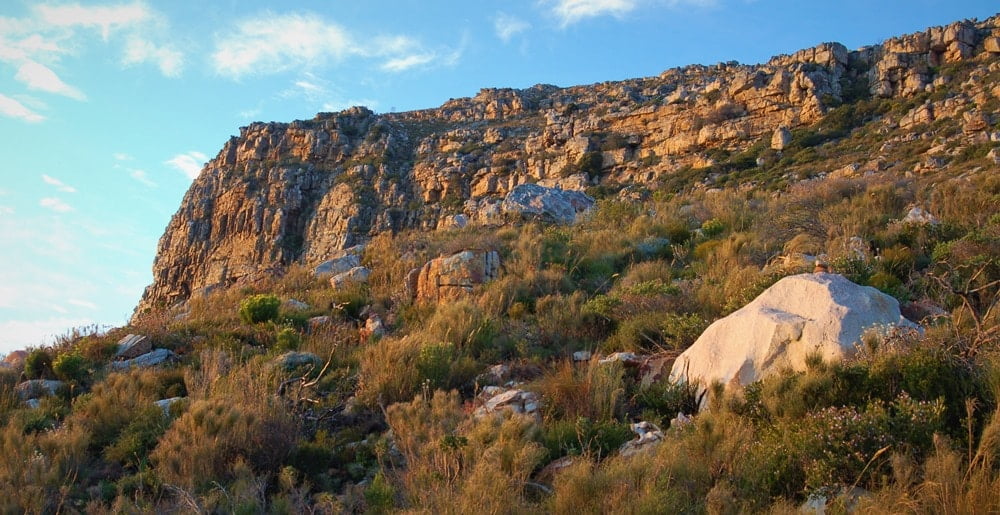What does it take to get a bit of mountain named after you? I mean, I’ve been tramping up and down these Cape Mountains for a quarter of a century and all I’ve got are dodgy knees and a stress fracture.
The thought occurred to me as I was hiking Elsie’s Peak, a modest lump of old sandstone looking out over False Bay and about 40 minutes south of Cape Town. Who was Elsie? The first one up or just someone who spent a lot of time on it? Did she once own this mountain or did she disappear one day while walking alone, the tragedy since passing out of memory.
And I wonder if Elsie knew she was on a goldmine.
A botanical goldmine of course – a real one would have levelled the mountain long ago. The prize here is not a precious metal (thankfully there are none in these mountains) but a glittering richness of shape, colour and scent. It was fynbos, as one would expect, but of such rampant, ever-changing diversity that even your writer – normally inured to floral-extravagance – was left gasping for superlatives.

North-facing Elsie’s Peak is a rugged landscape of steep cliffs & tumbled-down boulders baked by the sun all day.
There were great stands of fat-leaved semi-desert succulents, sheltered woodland thickets and wetlands carpeted in bronze-topped Restios – the Cape Reeds. Protea species changed every twenty minutes or so: Sugarbushes (Protea) and Conebushes (Leucadendron) giving way to Pincushions (Leucospermum) and Spiderheads (Serruria). Different kinds of heather (Erica) were in flower as were several plants you’ll be familiar with – at least in a garden context – such as Gladiolus, Silene and Felicia.

Botterboom (Tylecodon paniculatus) is normally a plant you’d find in the semi-deserts of the Karoo – it thrives here on the driest, sunniest side of Elsie’s Peak.
All of which led me to another question: just why is fynbos so generous with its species? Why have more than 650 different types of heather when Scotland has only four? And, since we’re on the subject, why cram so many of them into such small spaces? Table Mountain alone has a plant list as long as those of Sweden or the British Isles while the 70-kilometre long Cape Peninsula has more species of plant than Canada does. How does that work?
Elsie’s Peak has the answer.
The first great driver of fynbos diversity is experienced as you hike. Elsie’s Peak doesn’t even reach 200 metres (650 feet) above sea level but is made up of sheer cliffs, tumbling ravines, gentle slopes and seasonal swamps. There are sand dunes at her base and dripping grottos tucked away on her flanks. Hikers can expect to be roasted by heat and buffeted by the wind on the way up and then sent scrambling for a warm jersey at the top.

Making its home in the cracks of north-facing cliffs, the succulent Crassula rupestris is called Sosaties in Afrikaans, the local word for kebabs.
In other words, the rapidly changing nature of the environment – the geology, climate and exposure to the elements – encourages diversity. With all these different micro-habitats available, plants have evolved their way into all the nooks and crannies – or niches to give them their proper name – and the result plays out before your eyes. Thick-stemmed succulent plants such as Botterboom (Tylecodon paniculatus) dominate the steep, sun-baked north-facing slopes of Elsie’s Peak while damp flatland specialists like the Cluster Spiderhead (Serruria glomerata) appear wherever the terrain evens out. Fire-resistant ravines are home to stands of tall Buddleia trees while south-facing shady corners supported moisture-dependent ferns, mosses and carnivorous sundew plants (Drosera).

The Cluster Spiderhead – Serruria glomerata – is an unusual type of Protea & exists only in a few damp flats on the Cape Peninsula.

A shady spot on Elsie’s Peak is where you’ll find this Iris – Melasphaerula ramosa – known as a Baardmannetjie in Afrikaans – ‘little bearded men’.
Another driver of diversity is quickly revealed too: and it’s … silence.
It’s generally pretty quiet in fynbos: there’s not much humming and buzzing of insects and even fewer bird calls and certainly no large mammals crashing through the bushes ahead of us – but that’s normal. For animals, fynbos is a notoriously hard landscape in which to find food and that – somewhat counter-intuitively – may drive diversity.

One of the few animals you are likely to see in fynbos is Cordylus niger, called the Black Girdled Lizard by professionals but the Cape Crocodile by everyone else.
Because there are so few animals to interact with plants for things like pollination and seed dispersal, it seems that, once established, fynbos plants are often doomed to remain in their specific niche – a state known as ‘Naturally Rare’. Competition for the few available pollinating and dispersal agents may leave a plant beholden to a single localised pollinator – perhaps an earwig, beetle or small butterfly. And since fynbos plants rarely produce fruits, they forfeit the advantage of long-range seed dispersal via flying birds.
A glance across False Bay to the Kogelberg Mountains provided further evidence for this. Lying only 30 kilometres (nine miles) away, these mountains share the same geology and climate as the mountains of the Cape Peninsula and they have a similar number of plant species but over half of them are different types. It’s an extraordinarily large percentage for such a short distance and testimony to the ecological isolation of each area from each other despite their apparent closeness.

The Kogelberg Mountains are only an hour’s drive from Elsie’s Peak but the plants found there are mostly very different.
A third great mover behind this mysterious diversity is also unravelled in the landscape of Elsie’s Peak. You might think, especially if you are from North America or Europe, that the liberal scattering of boulders and mounds of loose rock throughout fynbos is a result of melting glaciers, dropping their rocky loads as glacial erratics (random boulders) and terminal moraines (piles or ridges of loose rock).

These truck-sized boulders were not left by retreating glaciers but are simply the remaining debris of mountains subjected to ferocious weathering conditions.
But the last glaciers in South Africa were 300 million years ago when the country was languishing at the South Pole. The point here is that the fynbos environment hasn’t suffered ecological catastrophe (crushing ice sheets, burning lava fields and the like) for millions of years and plants have therefore had plenty of time to find a niche and survive in it.
After all, for all my boasting about how many plant species there are in fynbos compared to other countries, you’ll notice I always use places that have endured recent environmental disaster such as Sweden, Canada, the British Isles and New Zealand. These countries were smashed by the last Ice Age which only ended around 20 000 years ago and many of their plants were wiped out; they have had to start again, from a botanical point of view. Fynbos, on the other hand, has been ticking over nicely in the warm sun for millions of years.

Gladiolus cunonius is called a Lepelbloom in Afrikaans, a Spoon Flower, & can be found in the sand dunes where Elsie’s Peak reaches sea level.
As for Elsie, well, it seems my imagination had been running away with me. It turns out that there was no Elsie; the peak takes its name from the modest river that runs nearby, named after the Rooi Els tree (Cunonia capensis). The Rooi Els (Red Alder in English) once grew along the river edges but were chopped down for timber and firewood long ago; the vernacular name for the tree – ‘Elsje’ – morphed into Elsie as Elsje’s Rivier became Elsie’s River. Not such a curious case perhaps. But it’s still a goldmine.

Elsie Revealed: Rooi Els, the tree from which the local river takes its name – Elsie’s River – & thus Elsie’s Peak.

What a wonderful piece of writing, revealing all the things we have wanted to know. I love it up there.
Thank you – I’m glad you know the place!
So stoked to read this, I’ve been running on Elsie’s for years and always thought it was special! Did you take the contour around the ‘face’ past the caves? The succulents along there are amazing!Let’s hope the rooikranz below don’t outsmother them.
On a side note it would be interesting reading your opinion on the fynbos at False Bay hospital. Currently the proteas and some Erica’s are in flower and I’m not sure how many valley bottom areas such as this remain intact in the Fish Hoek valley.
Thanks Sean, your instincts were right; it is indeed pretty special. And yes, Mike took me across the front face and we wiggled through some overhangs; he threatened to put a rope on me & go higher but I was too busy with the fynbos (my excuse anyway). False Bay hospital? Didn’t know there was one; I shall go and have a look – yes, the valley floor fynbos (what is left of it) can be very interesting – thanks for the tip.
There is Erica halicacaba up there. A cliff dweller kindly placed so that I too can see it.
Blimey, I had to look that one up: halicacaba … sounds like a word to open a magic door. I will look for it next time I’m there – I must have walked past them; interesting that the flower looks a bit like E urna-virdis of Silvermine but the habitat is obviously different. A recent split perhaps? Thanks for the tip.
Excellent again Dominic, wouldn’t mind a walk round there when we next visit!
Thanks Loyd, and yes, we’ll walk there – Elsie will be waiting!
Thanks for the interesting read Dominic. I always wondered where the name came from. Keep it up!
My mother used to hack there in the seventies and eighties, along with other groups. Now know someone who is devoted to hacking there still. Feel this article is a tribute to their work.
Thanks Natasha – Mike told me about the work that has gone on there – and is still going on, I saw chopped down rooi krantz. It sounds like it was a mess back then but if there’s ever proof that dedicated hacking works, it’s here. Mike pointed out a big stand of glorious proteas that was once a wattle forest. Kudos to all hackers!
I recall hiking on Elsies when the hacking started. The aliens created forests. Still hike there quite often. The fynbos in any season remarkable. Many thanks to the many retired gentlemen who started it all. Long gone
Another magnificent blog!
I like the afrikaans names – very descriptive.
Awesome photo’s too.
Thanks for telling the fascinating story of Fynbos Land’ wonders.
You have aroused a somewhat dormant fascination for fynbos lurking in the distant depths of my mind.
Your writing is truly inspirational.
Thank you!!
And thank you for reading the blog! I’m delighted a spark has been lit.
What a wonderful piece. Thank you. We are heading up to Elsie’s this morning with new eyes. And won’t bother searching for Elsie. Please add me to your mailing list.
Thank you – and I bet Elsie looked gorgeous this morning!
Only got 4 days in CT next weekend some up West Coast to see flowers but a friend said the flowers are lovely at Elsie’s Peak … then I found your lovely article and it sounds like a must do walk. Let’s hope the sun shines for all 4 days!
Also take a trip to the Good Hope Reserve – go to Olifantsbos on the Atlantic coast and you will see flowers like at the West Coast …
Great little peak indeed! It’s also home to an illustrious list of great rock climbing routes, including the quite astounding route called “Dream Street Route” that required around 100 falls for it to be opened by Andrew de Klerk – the best South African rock climber ever!!
Just a pity that the justified enthusiasm for this mountain (quite understandably) has clouded factual accuracy in several places in the otherwise lovely essay! But rather than being critical, I challenge you to find the inaccuracies! Another teaser is to find the « graffiti » that was scratched into the rock by English naval lookouts in 1937!!
So get out there and explore this fun filled little hill that packs s pretty punch!!
Hi Dominic -this read was a fantastic find thank you I often wondered where the name came from – Tomorrow I’m going up to clean the main drag up to the trail – a lot more walkers up there after the Tokai fires, but unfortunately that also means more dog waste. My business partner and I would like to start a social movement to do the right thing – we’ve developed dog walking bags for all your dog’s requirements and complete with a dog poop pouch. Follow us on Instagram #kaktas_co. We’d love to start a conversation to support the preservation of our vynbos biome, would you be interested ?